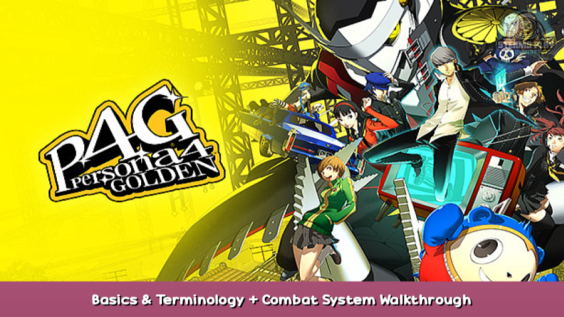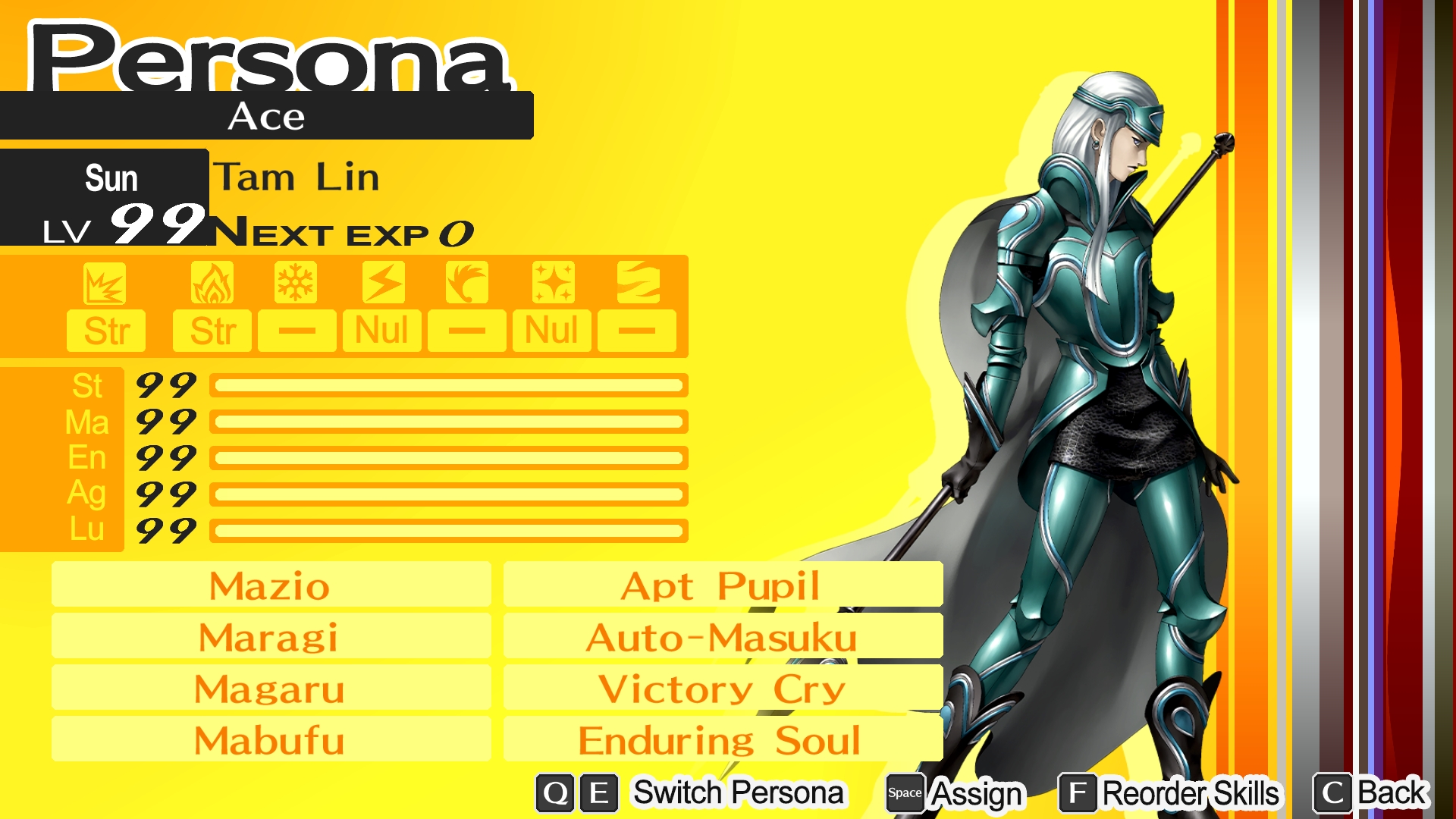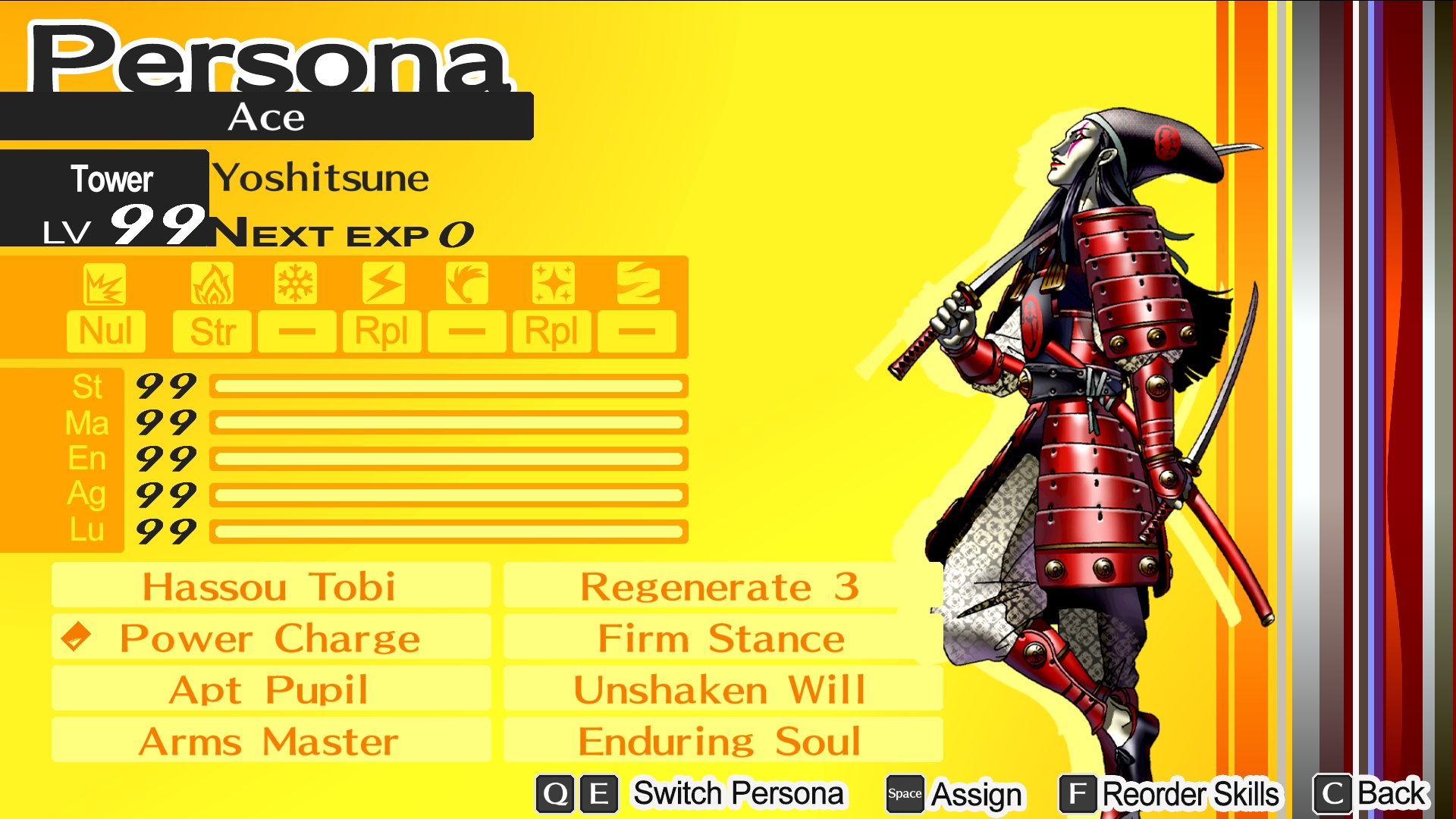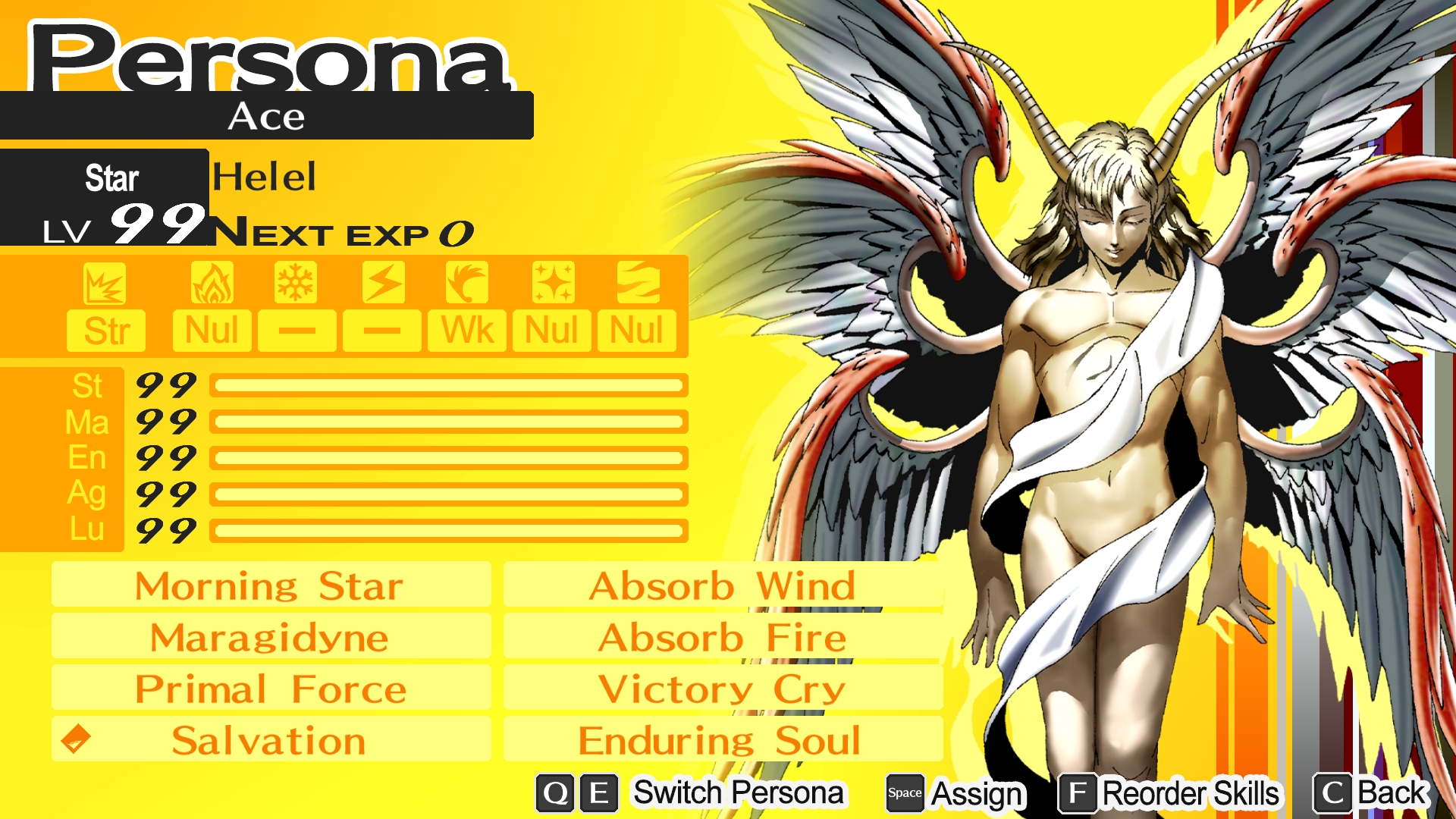
This is my third Steam guide, which will explain, analyse and streamline the combat aspect of this game. While a bit late to the party, in light of the upcoming P5R and P3P to Steam newcomers to the franchise may find this useful. Several tips from this can carry over to other Persona games, and even other Shin Megami Tensei games.
Introduction
Welcome to Persona 4 Golden – Guide. Due to the nature of this game, this is not a full walkthrough as a major part of the plot and story is it’s mystery. Instead, focus is exclusively placed on the combat aspect of the game. Spoilers will be kept to a minimum and names of characters/locations/events intentionally left vague.
Table of contents:
- Persona 4 Golden Basics
- Press Turn Combat System
- Fusion System
- Persona Expertise
- Persona Mastery
- Save Location
- Sources & Credits
WARNING: This guide contains spoilers for certain aspects of the game.
Difficulty
The game has 5 self explanatory difficulty settings. For a genuine challenging experience, the normal mode is recommended. If you are a Shin Megami Tensei veteran, you can go for Hard. It’s important to note Very Easy and Very Hard. Apart from altering damage dealt & received, these modes alter Exp and money acquisition as well. If you want to avoid grinding at all costs and speedrun through the story, chose Very Easy. Be prepared for extra grind on Very Hard.
In New Game+ you will be able to adjust the individual values at will. In your first game, this option is locked for the entire playthrough.
Persona 4 Golden Basics
Here lie some of the terminology used in the game and this guide for your convenience.
HP: your “hit points” or life. If it reaches 0, you die. If the main character dies, it’s game over.
SP: your “skill points” or mana. It is used to cast spells. Recovering SP is quite hard especially early on, and should be treated as a valuable resource.
LV: your level. Each persona level up increases 3 random stats by 1 point. Each character level up increases HP and SP by a little bit. Allies level together with their personas. As level increases, personas may learn new skills. Caps at 99.
Exp: experience points needed to advance a LV. Note that the level of the protagonist and his persona are independent of one another.
Stats: these cap at 99. Unlike HP & SP, these are bound to the persona:
St: your “strength” It determines your auto attack & physical skill damage.
Ma: your “magic” It determines spell damage.
En: your “endurance” It reduces incoming damage.
Ag: your “agility” It increases your hit rate & dodge rate as well as turn order.
Lu: your “luck” it increases the likelihood of auto attack & physical skill critical hit.
Elements in order of listing:
Physical
Fire (agi)
Ice (bufu)
Electricity (zio)
Wind (garu)
Light (hama)
Dark (mudo)
Almighty (not shown)
Resistances: Every persona has different strengths and weaknesses when it comes to elements.
Wk: “weak” taking damage of this element will knock down the character and inflict extra damage. The enemy gets 1 more turn.
-: “neutral” no extra damage or resistance.
Str: “strong” incoming damage of this element severely reduced.
Nul: “null” completely negates damage of this element.
Rpl: “repel” reflects damage of this element back to it’s source. If the source also has Rpl, it’s simply is negated as if it had Nul. This can heal the source if it has Dr.
Dr: “drain” incoming damage of this element heals the character instead.
The order of priority is: Dr > Rpl > Nul > Str > – > Wk
Pro tip: critical hits deal extra damage and knock down the enemy (similar to a Wk hit) even if the enemy is Str against physical. Unlike hitting a weakness however, they are activated randomly based on the attackers Lu. Only auto attacks and physical skills can result in critical hits.
Skills: Every persona can have up to 8 skills. Skills can be passive or active.
Shuffle Time: Sometimes after battle, various bonus cards will appear. They can have wide effects from increasing a persona’s stats, granting a skill card, more exp etc. If all are picked, a “sweep” takes place guaranteeing a shuffle time will occur on the next battle with a +2 card bonus pick ups.
Pro tip: when you obtain a skill card from shuffle time, be sure to save it and instead give it to the velvet room resident. You will then be able to buy it as much as you wish. This carries over to New Game+
Pro tip: be sure to talk to your characters and set their behavior as manual, allowing you to take full control of them during battle.
First Playthrough:
During your first playthrough outside of battles, enjoy the story and go in blind. If you want to prepare for your next run, make sure the protagonist’s main attributes are maxed since they can unlock social links which in turn, unlock ultimate personas.
During battle you can grind materials to unlock gear (these carry over to New Game+) and skill cards to give to the velvet room resident.
Press Turn Combat System
A staple of all Shin Megami Tensei games is the “press turn system” with various tweaks and changes from each title and franchise. Understanding how this system works in Persona 4 Golden is fundamental to not only combat, but persona builds latter on.
Battle takes place in “turns” In Persona 4 Golden (and other Persona games), each character has his turn individually. The order that each character and enemy has his turn is influenced by his Ag stat. Taking the enemy by surprise moves all allies to the top of the timeline. Conversely, being surprised lets even slower enemies act first.
Hitting an enemy’s weakness (or scoring a critical hit) however knocks down the enemy and allows the character to act again. Hitting an already knocked down enemy does not give another action, but it does make him dizzy, stunning them for 1 additional turn. The same rules apply for area attacks. Unlike the mainline SMT games, even if 1 enemy is knocked down from an area attack, another action is granted even if the other enemies repelled or absorbed the attack.
Assuming the character can keep knocking down enemies, there is no limit to how many times he can act per turn. Knocking down all enemies, prompts the party to do an all out attack that deals almighty damage, assuming the main character isn’t fighting alone and his allies can act.
Since the protagonists starting persona is electricity element, and the next 3 characters that join the party have wind, ice & fire elements respectively, it is recommended for newcomers to return to the first dungeon and practice utilizing and taking advantage of the “press turn system” until they fully understand how it works.
Keep in mind that all the rules explained above affect enemies as well. Enemies will take advantage of the party’s weaknesses to get more turns, often times purposely hammering down on a single ally to stun them.
While grinding levels and higher tier skills do have an impact, even a dyne level spell will still deal 0 damage if the enemy is Nul to it. And while having more HP and En helps, being hammered from an element you are weak will still inflict massive damage and stun-lock you. Understanding this system is the most important step of combat for Persona 4 Golden and all Shin Megami Tensei games in general.
Pro tip: Almighty damage can not be drained, repelled, nulled or resisted, but in turn can never be weakness and critical hit. Some enemies resist almighty, but can never drain, repel or null it either.
This makes almighty an expensive but reliable area spell. It lacks any boost/amp however making it’s potential damage limited.
Fusion System
Another staple of Shin Megami Tensei games is the fusion mechanic. In Persona 4 Golden, you can fuse 2 or more personas into a stronger one, inheriting skills along the way. You can fuse to stronger or even fuse back to weaker personas while keeping certain strong skills along the way.
You can have up to 8 active or passive skills at the same time in each persona. While early on the personas you get are adequate as long as you pay attention to elemental weaknesses, you will need to fuse powerful skills into a single persona to stay afloat.
The possible combinations and inheritance rules are myriad and above the scope of this guide, however you will find fusion calculators and other links in the “sources & credits” section of the guide.
An important thing to note is that the highest level persona of each arcana is it’s arcana “ultimate” persona and is only available after you reach level 10 with that respective social link. The item you get transfers over to New Game+ so you can fuse that persona from the get go (assuming your level is high enough)
While later on personas have stronger skill selections, you can give your starter personas amazing utility with a bit of time and effort with the fusion system.
Pro tip: the more skills the parent personas have (up to 8) the more possible skills the resulting persona can inherit. Triple or higher fusion always fills all blank slots with potential skills.
Persona Expertise
Having a firm understanding of the press turn system and persona stats, now comes the part of mastery. Through heavy use of the skill card system our personas can have almost all of the skills in the game even after fusion. So this leaves 2 important factors:
1) Unique skills: some skills do not exist as cards. Some exclusive skills can’t even be passed on.
2)Resistances: elemental resistances and weaknesses can be supplemented by skills, but they demand valuable skill slots. The less weaknesses and the more immunities a persona has, the better.
Max stats:
Remember that the limit for each stat is 99. No persona can come close to maxing all stats, even when taking the Lvl from 1 to 99. Each level up gives 3 random stats. To max all stats, heavy use of shuffle time stat boosting arcana must be made.
While these cards can be drawn after a persona has reached Lvl 99, drawing a stat that is already maxed is a waste. To avoid this, we want our persona to grind stats as early as possible, and let the rest fill up with leveling. A simple equation should look like this:
[stats needed] = [max stats – current stats]
[level ups remaining] = [99 – current level]
[total stat cards needed] = [stats needed] – [level ups remaining x3] +5 for safety
Note down how many cards you need to pick up, note down as you pick them up and stop once you have enough, the level ups should fill in the blanks.
For the reasons above the lower the level of our persona the better. Also, in New Game+ the rate of Exp gains can be set to low that also helps with innately high level personas. Remember Exp is shared with the party so always fight in a full team.
Starting persona: Izanagi
Izanagi is an adequate starting persona and your lightning dealer for the early game. Taking the magician cards from shuffle time will increase his cleave skill repeatedly all the way to the powerful god’s hand. Additionally, early game skill cards include dia and traesto which heal and let you escape a dungeon respectively, can be added for utility.
Pro tip: Keep in mind that support skills like healing and traesto can be used directly from the menu even outside of combat.
While we aim towards our first strong persona Izanagi will be a strong asset. If you are diligent in giving him skill cards through shuffle time, it’s not unlikely he can reach max stats at Lvl 99 as well. His wind Wk is a problem, unless you manage to pass down wind resist from Omoikane:
(example path):
Omoikane (7) + Ukobach (3) + Senri (9) = Obariyon (13)
Obariyon (13) + Yomotsu-Shikome (7) = Izanagi (1)
As long as Izanagi has lightning, a heal and traesto it is adequate for the early game. The next step is to find a persona with no natural weakness, in order to save up on skill slots. We will need those to fill him up with area elemental attacks.
Elemental caster: Obariyon
Obariyon (13) is an early persona and the first that has no innate weakness. Added to that he resists physical, a very common source of damage.
Slapping mazio, maragi, magaru and mabufu on him will allow Obariyon alone to trigger all elemental weaknesses on all enemies. Best thing about this is, even in end game these low level spells still knock enemies down, so he will never be obsolete.
You can get these spells from many sources, or evolve them from their single target variants with the magician card on shuffle time. However, since Obariyon will be casting a lot, watch out for your SP.
Useful additional skills:
Yatagarasu (46) gives the skill card cool breeze which restores HP and SP after each battle. The final secret persona of the game (91) gives the skill victory cry which fully restores HP and SP after each battle.
Ganesha (55) gives the skill card endure which lets you survive death with 1HP once per battle.
Attis (84) gives the skill card enduring soul which fully heals your HP from death once per battle. These are effective when targeted by mudo or hama skills as well.
Okuninushi (45) gives the skill card Apt pupil which increases the rate of critical hits, allowing you to sometimes knock down enemies, even when they have no weakness.
Kingu (58) gives the skill card Auto Masuki which automatically begins battles with sukukaja on the entire team. This increases your hit chance but more importantly your evasion. Melee auto attacks that are evaded knock down the enemy.
Keep in mind that there are way more powerful personas than Obariyon but become accessible later in the game. With minimal preparation, Obariyon can learn all the skills he needs through cards and shuffle time, leaving only stat gains (should you desire perfect 99 stats) The main point of this persona is his ability to hit all enemy weaknesses on his own.
Pro tip: assuming you have all 4 elemental spells, you might want to turn “act freely” back on for allies, as they will go for weakness as well and make battles go a lot faster.
Support: Neko Shogun (quad fusion of all mitamas)
While it’s true that salvation + victory cry means infinite healing these skills come into play near the end of the game, and Izanagi will start to struggle with media after the first few dungeons. Replacing him is Neko Shogun (32) which has access to some neat skill combos, namely, mediarama & divine grace. These 2 can almost fully heal the entire party at a fraction of salvation. Don’t forget to give him traesto so you can escape dungeons at will.
Nigi Mitama learns recarm, allowing you to resurrect allies as well, and Kusi Mitama learns traesto, these 2 are necessary for summoning Neko Shogun anyway, so it’s recommended you grab their skills along the way.
Persona Mastery
What persona you will chose to build as your end goal is entirely up to you. The following are some examples of interest that might get you into theory crafting yourself:
Trumpeter (67) and Beelzebub (81) have 4 immunities (Dr, Rpl, Nu) making it possible to make them immune to all damage except almighty with the least amount of cards. Note: Trumpeter also has no weakness.
To absorb all elements, Black Frost (38) is the best choice as he absorbs 2 elements and repels dark, since light/dark can’t be absorbed.
Since Dr takes priority over Rpl, if you want to have a persona that repels all attacks instead of just being immune, your options are limited. Namely, Satan (76) Yoshitsune (75) and Garuda (57) naturally repel 2 elements while not draining one. Note: Yoshitsune also has no weakness.
When you are immune to an element, boss enemies will opt to avoid using it on you, or use break skills to deal normal damage. Certain bosses will use almighty skills if you are immune to all elements.To avoid all this you can opt to intentionally not be immune to any (besides light/dark) instead being strong against all and taking firm stance to even further lower damage. High counter becomes valuable in this build, because unlike Rpl physical, the enemy will still attack you with physical attacks.
With that in mind, the most efficient personas for the job are Alraune (41), Tam Lin (53), Kaguya (74) and Narcissus (24) Note: Narcissus doesn’t nullify light/dark so potentially, he can repel those instead making him more powerful.
Finally personas with no innate weakness are: Ardha (90), Shiva (80), Mahakala (78), ultimate jester persona (77), Kohryu (76), Yoshitsune (75), Belial (68), Trumpeter (67), Kartikeya (67), Anubis (59), Kin-Ki (54), Tam Lin (53), Yatsufusa (49), Clotho (44), Dis (39), Black Frost (38), Taotie (35), Oni (30), Lamia (26), and Obariyon (13)
Pro tip: the skill card Absorb Physical, can only be obtained as a reward from the final dungeon of the game, rank 10 reward.
Exclusive skills that can’t be inherited or passed as cards:
Ragnarok – Surt (69)
Niflheim – Loki (64)
Thunder Reign – Thor (65)
Panta Rhei – Odin (74)
Hassou Tobi – Yoshitsune (75)
Morning Star – Helel (87)
Pralaya – Shiva (80)
Samsara – Daisoujou (60)
Die For Me! – Alice (72)
Black Viper – Satan (76)
Heaven’s Blade – Michael (72) & Metatron (83)
General recommendations:
While any persona with primal force and apt pupil is a very strong physical damage dealer, Yoshitsune deals, on average, more damage to bosses who often resist critical hits and affects all enemies with his Hassou Tobi. A great skill combo is:
Hassou Tobi / Primal Force
Apt Pupil
Arms Master
Power Charge
Regenerate 3
Absorb Physical
Ragnarok, Niflheim, Thunder Reign and Panta Rhei are single target elemental attacks that do more damage than dyne level spells. They can achieve the most magic damage with boost + amp passives. If you use them, don’t forget to take elemental break of the corresponding element to deal with immune enemies. A great skill combo is:
Ragnarok / Niflheim / Thunder Reign / Panta Rhei
Fire Break / Ice Break / Elec Break / Wind Break
Fire Boost / Ice Boost / Elec Boost / Wind Boost
Fire Amp / Ice Amp / Elec Amp / Wind Amp
Spell Master
Mind Charge
Morning Star, Die For Me! and Samsara are more powerful versions of megidolaon, mamudoon and mahamaon respectively.
The skills heaven’s judgment and hell’s judgement can only be obtained using the fusion forecast, and then can be inherited. (not really worth it though)
As a final tip: while you can min-max to perfection, the beauty of the game is using your knowledge to make your roleplay/sub optimal builds viable in all challenges. Here are some examples:
Save Location
For back-up purposes, here i will list the game’s save location. The game’s save files are located in:
c:\Program Files (x86)\steam\userdata\(user ID)\1113000\
This path is for Windows 10 64bit.
It goes without saying that this is the Steam version of the game. Game installed from elsewhere may or may not be in the same directory.
Sources & Credits
Certain information was found & was cross referenced in the following sites:
https://aqiu384.github.io/megaten-fusion-tool/p4g/personas – [github.io]
https://megamitensei.fandom.com/wiki/List_of_Persona_4_Personas – [fandom.com]
Here we come to an end for PPersona 4 Golden Basics & Terminology + Combat System Walkthrough hope you enjoy it. If you think we forget something to include or we should make an update to the post let us know via comment, and we will fix it asap! Thanks and have a great day!




Leave a Reply